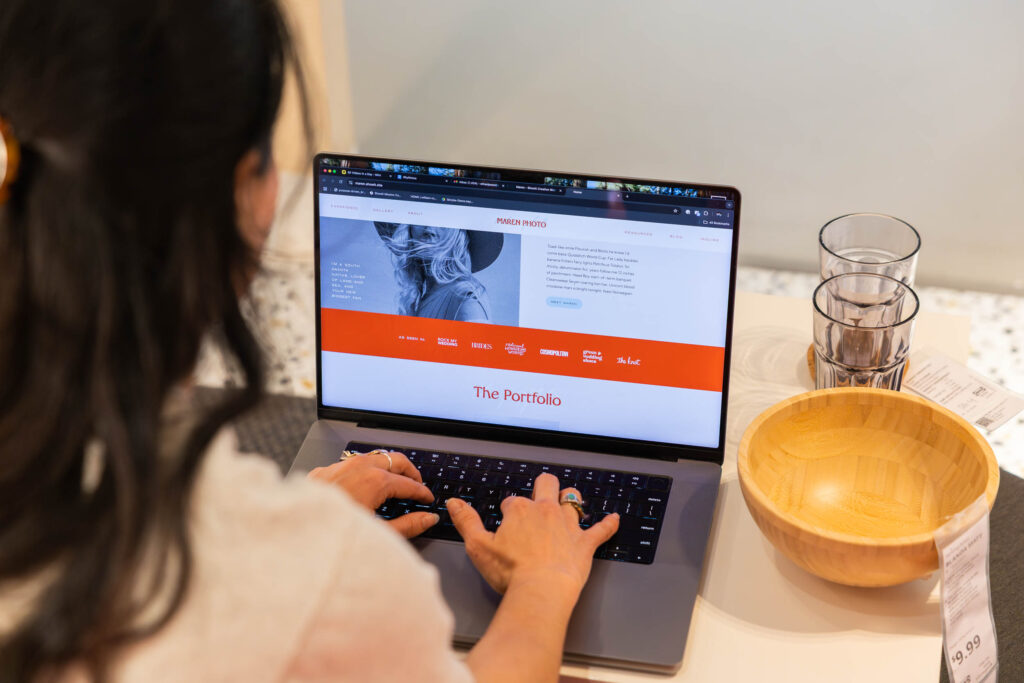Wondering if it's time to shake things up with your business offerings?
Maybe bookings for your signature service have slowed down a bit or you're hearing requests from your audience that you're not quite serving yet.
Or maybe you're just thinking ahead, wanting to build some financial resilience before you actually need it.
(Smart move, by the way.)
When tough seasons hit (and they will!), you want to make sure you have options. Multiple income streams give you flexibility, stability, and the confidence to weather any storm.
You're not being flaky by expanding your offers. You're being strategic.

Why Diversification Matters, Especially Now
Creative businesses thrive on flexibility, and having multiple income streams is like having a financial safety net that actually works for you.
When one revenue stream slows down, you've got others to lean on. It's not about panic-planning, it's about abundance-planning.
Think of it this way: “Having different offers is like packing layers for a trip. You won't always need them, but when you do, you'll be glad they're there.”
Diversification can transform your business:
- It provides financial stability when your main offer experiences seasonal dips.
- It serves different segments of your audience who might want to work with you at different price points
- It creates passive income opportunities that work for you even when you're not actively working
- It gives you creative outlets to explore new aspects of your expertise
- It builds long-term business resilience so you can adapt as markets change
The best part is that you don't have to reinvent the wheel or abandon everything you've worked so hard to build.
What Tough Seasons Reveal: Double-Down, Pivot, or Expand
When business slows down, we often find ourselves wondering if we should keep pushing a specific offer harder… or switch things up completely.
The truth is that it doesn't have to be either/or.
You've got three strategic options, and the right choice depends on what you're seeing in your business:
Double down if your main offer still aligns with market demand. Consider getting it in front of more people or refining your messaging.
Pivot if your audience's needs have genuinely shifted and your current offer isn't hitting the mark anymore.
Expand if you're receiving requests you're not yet serving, or if you want to create multiple ways for people to work with you.
Here's some real-world language to help you figure out which route makes sense: If bookings for your top-tier brand photoshoots are slowing, maybe it's time to introduce mini sessions for budget-conscious clients or launch a DIY branding course for entrepreneurs who can't afford full-service work yet.
The key is to pay attention to what your audience is telling you, both directly through their words and indirectly through their actions (or lack thereof).

Three Ways to Diversify Without Losing Your Brand Identity
You already know your audience inside and out. This is just about meeting them where they are, at different stages of their journey with different needs and budgets.
#1 – Tiered Services: Same Expertise, Different Formats
This is probably the easiest way to start diversifying, because you're essentially taking what you already do and packaging it differently.
Examples:
- If you offer one-on-one coaching, add group coaching or workshops
- If you do full-day brand photoshoots, introduce half-day or mini sessions
- If you provide comprehensive website design, offer template customization services
The beauty of tiered services is that you're still doing what you do best; you're just making it accessible to people with different budgets, timelines, or commitment levels.
#2 – Productize Your Knowledge: Turn Your Process Into Profit
Think about everything you know that your clients always ask you about. All those tips you share, those processes you've perfected, those “quick fixes” that come naturally to you — that's gold waiting to be packaged.
Examples:
- Create templates based on your successful projects
- Develop guides that walk people through your process
- Offer workshops teaching skills you use in your services
- Build online courses around your area of expertise
The amazing thing about productized knowledge is that you create it once, and it can sell repeatedly with minimal additional effort from you.
#3 – Recurring Revenue: The Foundation of a Resilient Creative Business
This is where we need to spend serious time, because recurring revenue is the secret weapon that most creatives completely overlook—and it's honestly the most transformative thing you can add to your business.
Recurring revenue means money that comes in regularly, month after month, without you having to constantly find new clients or make new sales. Think subscriptions, memberships, retainers, or ongoing services.
Why recurring revenue changes everything:
- Predictable income that you can count on every month
- Stronger client relationships because you're working together over time
- More efficient business operations since you're not constantly onboarding new people
- Higher lifetime value from each client relationship
- Financial stability that gives you confidence to plan and invest in your business
- Reduced stress from the feast-or-famine cycle that plagues most creative businesses
How to Add Recurring Revenue to Your Business
Retainer Relationships:
- Brand photographers: Monthly content creation for social media
- Web designers: Ongoing website maintenance, updates, and optimizations
- Copywriters: Regular blog writing or email marketing services
- Coaches: Monthly strategy sessions or check-ins
- Virtual assistants: Ongoing administrative support
Membership Communities:
- Create a monthly membership where clients get ongoing resources, templates, mini-trainings, and direct access to you
- Offer different tiers: basic ($29/month for resources), premium ($99/month for group calls), VIP ($199/month for direct access)
- Example: A brand photographer could create a membership teaching DIY photography skills with monthly photo challenges and feedback
Subscription-Based Services:
- Monthly design work (think brand assets, social media templates, or marketing materials)
- Regular coaching calls or mastermind groups
- Content creation services delivered consistently
- Educational resources or courses delivered in modules over time
Done-With-You Programs:
- 6-month brand transformation programs with monthly check-ins
- Quarterly business strategy intensives
- Annual website optimization and updates
- Monthly group coaching with individual support
Subscription Boxes or Resource Delivery:
- Monthly template packs for your niche (website templates, proposal templates, etc.)
- Regular educational content delivered via email or private podcast
- Access to a growing library of resources that gets updated monthly
The Key to Making Recurring Revenue Work:
Think about what your clients need after they work with you, or what they need to stay successful in the long run. That gap between your one-time service and their ongoing needs is where your recurring revenue opportunities live.
For example:
- After you design someone's website, they need regular updates and maintenance
- After you do their brand photos, they need ongoing content for social media
- After you write their sales page, they need regular email marketing
- After you coach them through a launch, they need ongoing strategy support
Start Small With Recurring Revenue:
Pick ONE recurring offer and test it with your existing clients first. Maybe it's a monthly maintenance package for past web design clients, or a quarterly strategy session for past coaching clients.
See how it goes, refine it, then expand from there.
Retain Your Earnings: Financial Readiness Is Creative Freedom
Being financially prepared isn't boring — it's empowering.
Using profitable seasons to build a financial cushion gives you the freedom to experiment when things slow down, instead of scrambling to react out of panic.
When you've got money in the bank, you can…
- Take time to thoughtfully develop new offers
- Say no to projects that aren't a good fit
- Invest in the tools and resources you need to grow
- Weather slow periods without stress
- Make strategic decisions from a place of confidence, not desperation
Think of saving money as buying yourself creative freedom and peace of mind.
Being financially ready isn't boring. It's brave.
It takes courage to put money aside when you could spend it on something fun right now. But that discipline is what separates businesses that thrive from businesses that barely survive.

Your Action Plan: Start Small, Think Strategic
Diversifying doesn't mean diluting your brand—it means strengthening it by creating multiple ways for your ideal clients to work with you.
Here's how to get started:
Step 1: Look at your current client base and identify patterns in their requests or needs that you're not currently serving.
Step 2: Choose ONE diversification strategy to focus on first. (We recommend starting with recurring revenue if you don't have any yet!)
Step 3: Create a simple version of your new offer and test it with a small group of existing clients or your email list.
Step 4: Refine based on feedback, then officially launch it.
Step 5: Once that's running smoothly, consider adding another income stream.
Remember: small changes can open big opportunities. You don't need to overhaul your entire business overnight.
Bottom Line: Diversifying your offers isn't about abandoning what you’ve built; it's about maximizing it.
You've worked hard to build expertise in your niche, and you've attracted an audience who trusts you. Diversifying your offers isn't about abandoning that—it's about maximizing it.
When you create multiple ways for people to work with you, you're not just building a more resilient business. You're building a business that can serve your audience at every stage of their journey, while creating the financial stability that gives you true creative freedom.
Build those savings so you can move with confidence, not panic. Create those additional income streams so you have options when you need them. And most importantly, remember that diversification is a sign of strategic thinking, not brand confusion.

